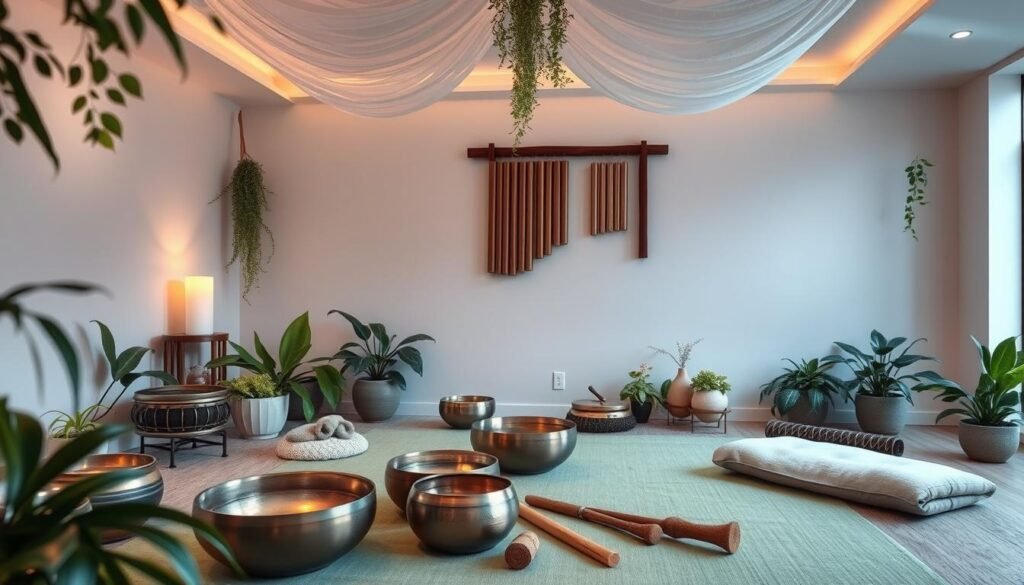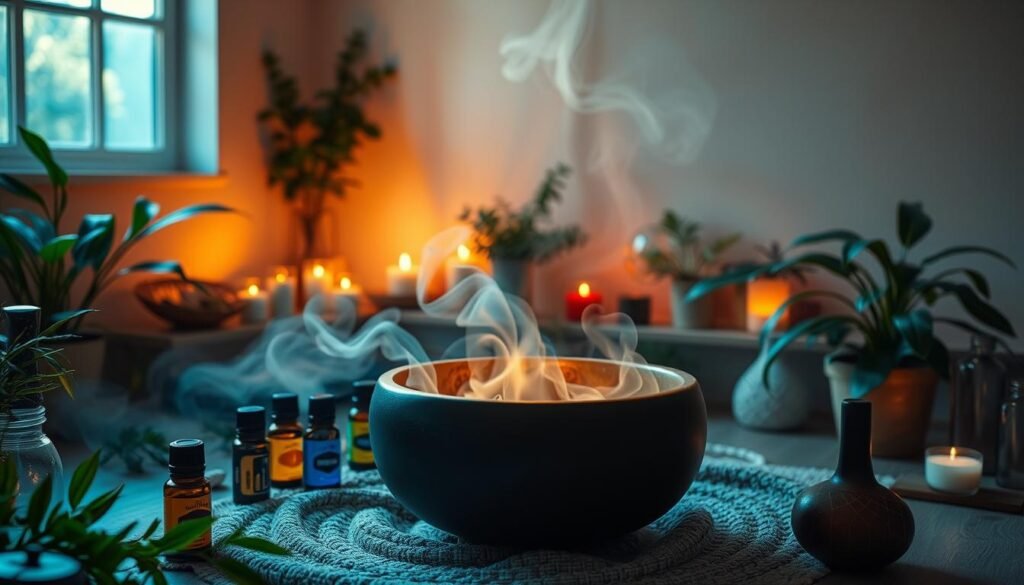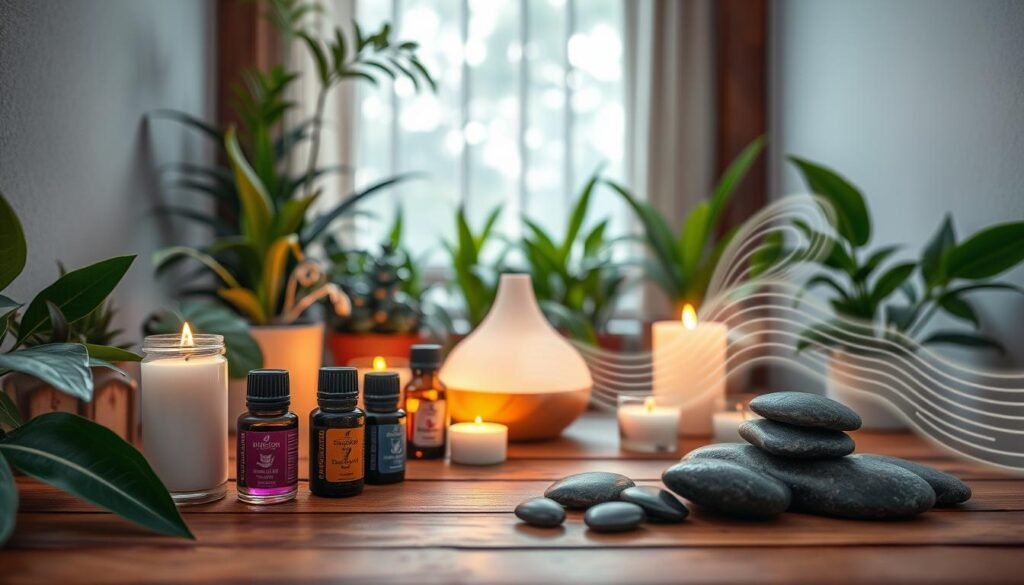Did you know that over 30% of Americans use essential oils in their wellness routines? This fact highlights the importance of Aromatherapy and Sound in enhancing holistic wellness. By using essential oils and sound vibrations, people improve their emotional and physical health.
This article explores the unique benefits of aromatherapy and sound therapy. From their historical origins to modern-day use, these therapies offer relaxation and balance. Aromatherapy uses plant extracts to calm the mind, while sound therapy heals through vibrations. Together, they create a peaceful sensory experience that fosters a deep connection with oneself.
Key Takeaways
- Aromatherapy utilizes essential oils to enhance physical and emotional well-being.
- Sound therapy promotes relaxation and mental clarity through sound waves.
- Combining aromatherapy and sound deepens mindfulness and meditation practices.
- Essential oils like Lavender and Chamomile are popular for relaxation.
- Aromatherapy can improve sleep quality by reducing anxiety.
- Both therapies positively influence the autonomic nervous system.
Understanding Aromatherapy
Aromatherapy is a holistic healing method using essential oils from plants. These oils, taken from different parts of the plant, have unique benefits. They work on both the body and mind. With almost a hundred types of essential oils, aromatherapy offers a wide range of health solutions.
What is Aromatherapy?
The term “aromatherapy” came into use in 1937, thanks to René-Maurice Gattefossé. It’s about using special fragrances to relax, reduce stress, and boost mood. Oils like lavender, eucalyptus, and rosemary are popular choices. However, it’s important to talk to a doctor before using aromatherapy as a treatment.
History and Origins of Aromatherapy
Aromatherapy has been around for thousands of years. Ancient cultures in Egypt, Greece, and other places used aromatic plants for healing. By the 19th century, French doctors began applying essential oils in medical treatments. This long history shows both cultural and medical interest in aromatherapy.
How Aromatherapy Works in Healing
Essential oils affect the brain’s limbic system, leading to healing effects. For example, lavender oil, with its calming compounds, helps with sleep and reducing stress. Oils like jasmine and sandalwood also calm the mind and improve sleep. But, people should use these oils carefully. Always consult a doctor first, especially for children or if you’re pregnant. And, mix essential oils with a carrier oil to avoid skin problems.
In summary, aromatherapy uses essential oils’ natural benefits for healing. It’s great for those looking for natural ways to ease anxiety or stress. For more information, consider looking into hemp oil and essential oils as part of your daily wellness routine.
Essential Oils: The Heart of Aromatherapy
Essential oils are key to aromatherapy, known for their smell and health benefits. Each oil has unique features to help with emotional and physical needs.
Types of Essential Oils and Their Benefits
There are many essential oils, each with its own benefits. Here are a few:
- Lavender – Known for its calming effects, it helps relieve stress and improves sleep.
- Eucalyptus – Famous for its refreshing effects, it helps refresh the mind and body.
- Chamomile – Aids in relaxation and boosts mental clarity.
- Bergamot – Its citrus smell helps increase happiness.
These oils can be used in diffusers, candles, and on the skin. They have thousands of compounds that make them powerful and effective.
Popular Essential Oils for Relaxation and Healing
Aromatherapy can create a calming space and focuses on healing. Essential oils work well with meditation to improve the experience. Great oils for calming include:
- Ylang-Ylang – Helps lower anxiety and stress.
- Frankincense – Enhances spiritual awareness during meditation.
- Peppermint – A refreshing oil that helps focus the mind.
To learn more about essential oils and safe practices, it’s good to seek information. It’s best to talk to a professional, especially if you have health issues. For more details on essential oils and their benefits, check this guide here.
Sound Therapy: An Overview
Sound therapy is a key method for improving our mental, emotional, and physical health. It uses different sound waves and auditory stimulation to create peace. By blending music, nature sounds, and special instruments, it aims to match the body’s natural vibrations. This helps bring calmness and balance.
What is Sound Therapy?
Sound therapy, or sound healing, uses sound on purpose to heal. It includes music therapy and nature sounds for a full sensory experience. This practice aims to use sound’s power to lessen stress and improve well-being. It connects the mind and body through sound.
How Sound Therapy Works on the Mind and Body
Sound therapy affects the brain and body through vibrations. Techniques like binaural beats help achieve deep relaxation and mental stability. Studies show it can break through negative energy, making one feel refreshed. Certain frequencies have been found to lower anxiety and improve health.

| Sound Therapy Benefits | Description |
|---|---|
| Stress Reduction | Sound therapy has been shown to decrease cortisol levels, leading to reduced stress. |
| Improved Mood | Engaging with music and sound can elevate mood and promote feelings of happiness. |
| Enhanced Focus | Specific types of auditory stimulation can improve concentration and mental clarity. |
| Physical Healing | Sound vibrations aid in alleviating pain and promote faster recovery in various conditions. |
The Healing Role of Aromatherapy and Sound
Aromatherapy and sound therapy together make a special way to boost wellness. This mix gives a healing experience that helps our body and mind. People find they relax more deeply when using both methods. Young Living essential oils and sound work together to calm the atmosphere.
Combining Aromatherapy and Sound Therapy for Maximum Effect
Blending essential oils with sound therapy enhances both their strengths. For example, lavender oil and calming sounds can reduce stress hormones. This helps with mental focus and emotional steadiness. Such combinations make relaxation deeper, aiding in personal wellness exploration.
Benefits of a Multi-Sensory Experience
Using more senses in healing improves the overall experience. It changes brain waves and boosts hormones like serotonin. This balances our physical and mental states. Using certain essential oils and sounds helps with emotional healing. It aids relaxation and encourages emotional and spiritual self-care.

Aromatherapy and Sound in Daily Life
Adding aromatherapy to your daily routine can really boost relaxation. By mixing essential oils with sounds, you create special moments. These moments can be calming experiences. They can include using scents, listening to calm music, or meditating with sound bowls.
Creating a Personal Aromatherapy and Sound Routine
There are many ways to start an aromatherapy and sound habit. You might like lavender or chamomile oils because they’re soothing. Adding the sounds from Tibetan singing bowls can make it even better. Baths with these oils or listening to nature sounds can help you unwind. Trying different mixes helps you find what’s best for you, for a cozy and healthy ritual.
Tips for Integrating Aromatherapy and Sound into Relaxation Techniques
There are many ways to mix senses into relaxation. Here are some ideas:
- Use a diffuser with calming scents and listen to soft tunes or nature sounds.
- Add essential oils to massages and pair it with music for more relaxation.
- Use sound bowls or gentle chants with scents like sandalwood during meditation.
- Create a soothing night routine with a warm bath, LED candles, and calming oils.

Building a fulfilling routine with aromatherapy and sound deepens relaxation in daily life. Embracing these habits helps us on our path to well-being.
| Scent | Main Benefits | Complementary Sound Therapy |
|---|---|---|
| Lavender | Promotes relaxation and aids sleep | Tibetan singing bowls |
| Chamomile | Reduces stress and anxiety | Calming music playlists |
| Bergamot | Elevates mood and reduces cortisol | Nature soundscapes |
| Sandalwood | Enhances focus and tranquility | Binaural beats |
Enhancing Mental Health with Aromatherapy and Sound
Aromatherapy and sound therapy are great for improving mental health. Together, they can help reduce anxiety and stress. Studies show that essential oils like lavender and chamomile, combined with peaceful music, can create a healing and calm atmosphere.
Reducing Anxiety and Stress through Sensory Experiences
A Korean study on nursing students showed the benefits of using both aromatherapy and sound therapy. These students felt less test anxiety and stress when both methods were used together. Even patients getting MRI exams felt more at ease with aromatherapy and soft tunes.
Here are several benefits of this approach:
- About 95% of people felt less anxious after sessions with soothing sounds and aromatherapy.
- Regular use of aromatherapy can cut stress by up to 50%, especially in stressful work environments.
- Seven out of ten people slept better by using calming scents at night.
Sound therapy alone has been proven to boost mood and energy in 85% of people. When used with aromatherapy, it leads to better mental focus and emotional balance. More research could help find even better ways to use these therapies for mental health.
For more about using aromatherapy in healthcare, visit this resource. For science-backed calming music, see this article.
Safety Considerations and Precautions
Aromatherapy brings many benefits, but safety is crucial, especially for some people. Many people find relief through essential oils and sound therapies. Yet, certain groups need to be extra careful. Knowing about essential oils and their risks can improve your experience.
Who Should Avoid Aromatherapy?
Some should be careful with aromatherapy. These groups need to watch out:
- Pregnant women, who may risk absorption of essential oils into the placenta.
- Children under six months, requiring specialized formulations due to their sensitivity.
- Individuals with pre-existing health conditions, particularly respiratory issues like severe asthma.
- Those with allergies, who should consult professionals before utilizing essential oils.
- People on medication, particularly those that may interact dangerously with specific essential oils.
Best Practices for Using Essential Oils and Sound Therapy
To have a safe aromatherapy and sound therapy experience, you need to follow some guidelines. Using these tips and being careful with essential oils will help you:
- Always dilute essential oils in a carrier oil before applying to the skin, typically at a concentration of 1 to 3 percent.
- Perform patch tests prior to extensive usage to check for any skin sensitivities or irritations.
- Keep essential oils out of reach of children to prevent accidental ingestion or application.
- Store essential oils in a cool, dark place, ideally a refrigerator, to maintain their quality.
- Avoid applying essential oils directly to the eyes, as they can cause serious damage.
- Ensure proper ventilation during use to minimize inhalation of high concentrations.
- Wash hands after each use and maintain hygiene to prevent contamination.
- Limit the use of certain oils, especially during pregnancy, as some may pose risks.
This table shows which essential oils to be cautious with due to reasons like pregnancy, age, or health issues:
| Essential Oil | Avoid If… |
|---|---|
| Cinnamon Oil | Skin irritations can occur; avoid on sensitive skin. |
| Hyssop | Pregnant or breastfeeding women should avoid this oil. |
| Chamomile | People with allergies to ragweed should be cautious. |
| Peppermint | Avoid for children under 2 years old. |
| Tea Tree Oil | Check for oxidation; older oils may cause rashes. |
| Rosemary | Avoid for pregnant women and those with seizures. |
Future Trends in Aromatherapy and Sound Therapy
Aromatherapy and sound therapy are becoming big parts of wellness. They help improve mental and emotional health. People are using these methods more in their health routines. This growth is supported by new markets and creative uses of these therapies.
Growing Popularity and Acceptance in Wellness Practices
The market for aromatherapy diffusers is expected to hit USD 1,794.4 million in 2023. It will grow by 8.6% each year from 2024 to 2030. This shows how much people are getting into wellness that involves all-around healing.
- North America is a big player, with over 54% of the market share in 2023.
- The ultrasonic product segment claimed 66.9% of the market. This shows people prefer efficient ways to use these products.
- Spas are coming up with new ways to use these therapies. They aim to give unique experiences by using AI and knowing what each person needs.
Research Developments in Aromatherapy and Sound Healing
Studies are showing how good these therapies can be. Aromatherapy is proving useful for stress relief and health. Interesting research says:
“78 minutes of music daily is optimal for mental health improvement,” according to the British Academy of Sound Therapy.
Music affects our brains in positive ways. There’s more money now to study its benefits, like the $20 million Sound Health Initiative. Scientists are using tech and AI to make healing music that’s just right for each person. This is what’s next for sound therapy.
| Market Segment | 2023 Share (%) | CAGR 2024-2030 (%) |
|---|---|---|
| Aromatherapy Diffusers | 1,794.4 million | 8.6% |
| North America | 54% | – |
| Ultrasonic Diffusers | 66.9% | – |
| Spa & Relaxation | Largest Segment | – |
| Personalized Music Therapy | Expanding Market | – |
Conclusion
Aromatherapy combined with sound therapy is a groundbreaking way to improve wellness. Using essential oils like lavender mixed with calming sounds can help us heal. Studies show these methods ease stress, lift moods, and boost energy.
These old practices connect us better with ourselves in today’s busy world. By choosing the right oils and sounds, you can create a personalized care routine. This combination opens up new paths for emotional and physical health.
Adding these therapies to your daily routine can brighten your spirit. They might even help you sleep better and practice mindfulness more effectively. As we keep exploring these therapies, we can turn daily moments into chances for deep healing. This can lead to a life that’s more peaceful and balanced.